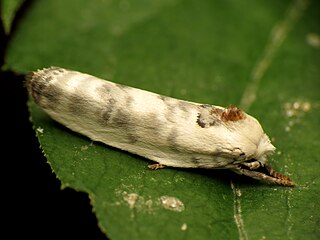
Antaeotricha is a genus of moths. It is the largest genus in the subfamily Stenomatinae, numbering over 400 species in the Western Hemisphere.
Antaeotricha vacata is a moth of the family Depressariidae. It is endemic to Grenada and Trinidad in the Caribbean.

The Stenomatinae are a subfamily of small moths in the family Depressariidae.
Antaeotricha walchiana is a moth of the family Depressariidae. It is found in Venezuela, Panama, Trinidad, Colombia, French Guiana, Brazil, Bolivia and Peru.
Antaeotricha spurcatella is a moth of the family Depressariidae. It is found in Guyana and Honduras.
Antaeotricha disjecta is a moth in the family Depressariidae. It was described by Philipp Christoph Zeller in 1854. It is found in Costa Rica, the Guianas, Bolivia and Brazil (Para).
Antaeotricha fascicularis is a moth in the family Depressariidae. It was described by Philipp Christoph Zeller in 1854. It is found in Guyana, French Guiana and Brazil (Amazonas). It is located in rainforests where they can thrive due to the abundance of vegetation and a large amount of suitable host plants for the moths larvae, where the newly hatched caterpillars then feed of their host plant

Antaeotricha leucillana, the pale gray bird-dropping moth, is a moth in the family Depressariidae. It was described by Philipp Christoph Zeller in 1854. It is found in North America, where it has been recorded from New Hampshire, Massachusetts, New York, Pennsylvania, District of Columbia, Virginia, North Carolina, Georgia, Alabama, Arkansas, Missouri, Kansas, Illinois, Iowa, Texas, Oregon, Louisiana, Manitoba and Nova Scotia.
Antaeotricha radicalis is a moth in the family Depressariidae. It was described by Philipp Christoph Zeller in 1877. It is found in Panama.
Antaeotricha semicinerea is a moth in the family Depressariidae. It was described by Philipp Christoph Zeller in 1877. It is found in Panama, Guatemala and Brazil (Amazonas).
Antaeotricha spurca is a moth in the family Depressariidae. It was described by Philipp Christoph Zeller in 1855. It is found in Amazonas, Brazil.
Antaeotricha frontalis is a moth in the family Depressariidae. It was described by Philipp Christoph Zeller in 1855. It is found in Mexico and Guatemala.
Antaeotricha humilis, the dotted anteotricha moth, is a moth in the family Depressariidae. It was described by Philipp Christoph Zeller in 1855. It is found in North America, where it has been recorded from Alabama, Arkansas, Florida, Georgia, Illinois, Indiana, Kansas, Kentucky, Louisiana, Maryland, Mississippi, New Jersey, North Carolina, Ohio, Oklahoma, South Carolina, Tennessee, Texas, Virginia and West Virginia.
Antaeotricha unisecta is a moth in the family Depressariidae. It was described by Edward Meyrick in 1930. It is found in Brazil.
Antaeotricha isoporphyra is a moth in the family Depressariidae. It was described by Edward Meyrick in 1932. It is found in Costa Rica.
Antaeotricha isosticta is a moth in the family Depressariidae. It was described by Edward Meyrick in 1932. It is found in Mexico.
Antaeotricha monocolona is a moth in the family Depressariidae. It was described by Edward Meyrick in 1932. It is found in Bolivia.
Antaeotricha phaselodes is a moth in the family Depressariidae. It was described by Edward Meyrick in 1931. It is found in Brazil.
Antaeotricha pyrobathra is a moth in the family Depressariidae. It was described by Edward Meyrick in 1931. It is found in Brazil.
Antaeotricha cicadella is a moth in the family Depressariidae. It was described by Sepp in 1830. It is found in the Guianas.


